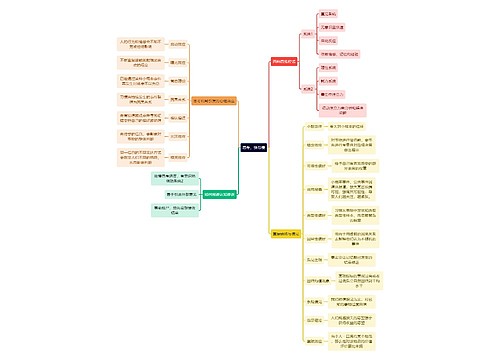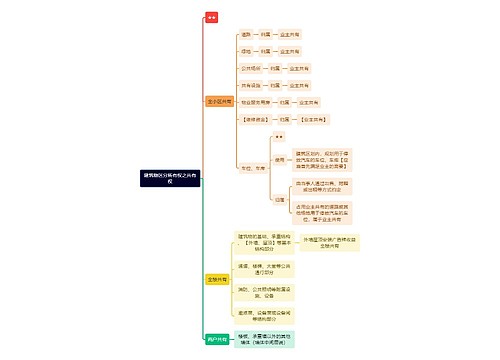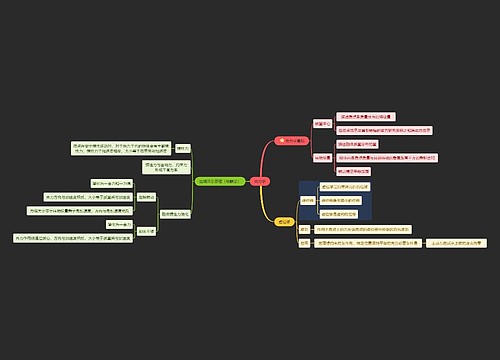
读书笔记《第一哲学沉思集》论上帝及其存在思维导图
ZYJ
2022-10-30

怎么看待理性
如何理解观念
笛卡尔循环
理性和观念以及笛卡尔循环
树图思维导图提供《读书笔记《第一哲学沉思集》论上帝及其存在》在线思维导图免费制作,点击“编辑”按钮,可对《读书笔记《第一哲学沉思集》论上帝及其存在》进行在线思维导图编辑,本思维导图属于思维导图模板主题,文件编号是:057e5e377112288365bb56efce27de5e
思维导图大纲
相关思维导图模版
读书笔记《第一哲学沉思集》论上帝及其存在思维导图模板大纲
L7 第三沉思 PPT 理性与观念
一、回顾总结
摆脱感官: “现在我要闭上眼睛,堵上耳朵,脱离开我的一切感官,我甚至要把一切物体性的东西的影象都从我的思维里排除出去,或者至少(因为那是不大可能的)我要把它们看做是假的;这样一来,由于我仅仅和我自己打交道,仅仅考虑我的内部,我要试着一点点地进一步认识我自己,对我自己进一步亲热起来。” -- doubtful 怀疑的东西
我是一个思想物:“我是一个在思维的东西,这就是说,我是一个在怀疑,在肯定,在否定,知道的很少,不知道的很多,在爱、在恨、在愿意、在不愿意、也在想象、在感觉的东西。” -- certain 确定的东西
二、真理规则
清楚明白的知觉都是真的:“我确实知道了我是一个在思维的东西;但是我不是因此也就知道了我需要具备什么,才能使我确实知道什么事情吗?在这个初步的认识里,只有我认识的一个清楚、明白的知觉。老实说,假如万一我认识得如此清楚、分明的东西竟是假的,那么这个知觉就不足以使我确实知道它是真的。从而我觉得我已经能够把“凡是我们领会得十分清楚、十分分明的东西都是真实的”这一条订为总则。”
论证过程:
1. 我确切地知道我是一个在思想的事物。
2. 这种知识的唯一根据,是清楚明白地知觉其真理。
3. 假如它以某种方式可错,那么,清楚明白的知觉就不足以产生这种知识。
4. 因此,清楚明白的知觉为这种知识提供充分依据;凡是我如此知觉的东西都是真的。
三、如何辨认清楚明白
如何得知我们的知觉是清楚明白的?如何界定清楚明白?
伽桑狄在第五反驳中就屡次提出这样的疑问:如果分不清楚知觉是否清楚明白,那么,真理规则也就毫无意义。
《沉思集》没有定义何为清楚明白的知觉,只是让沉思者遵循一个秩序:
先是避开感官,思考自己的心灵,直至“习惯于清晰地知觉自己的心灵;
接着考察自明的命题,以训练“理智的眼力”或“明白性”,考察包括上帝在内的各类事物的本性或本质的观念,
然后反思各沉思提供的清楚明白的知觉和含混模糊的知觉。
第三沉思强调我们有“清楚明白的”上帝观念。
四、上帝是不是骗子
第二沉思:假设上帝骗人,是为了怀疑物质世界和数学真理
“可是,我在这些东西里边曾领会得清楚、明白的是什么呢?当然,假如从那以后,我认为可以对这些东西怀疑的话,那一定不是由于别的理由,而只是因我心里产生这样一种想法,即也许是一个什么上帝,他给了我这样的本性,让我甚至在我觉得是最明显的一些东西上弄错。但是每当上述关于一个上帝的至高无上的能力这种见解出现在我的思维里时,我都不得不承认,如果他愿意,他就很容易使我甚至在我相信认识得非常清楚的东西上弄错。”
第三沉思:上帝并非骗子
“可是反过来,每当我转向我以为领会得十分清楚的东西上的时候,我是如此地被这些东西说服,以致我自己不由得说出这样的话:他能怎么骗我就怎么骗我吧,只要我想我是什么东西,他就决不能使我什么都不是;或者既然现在我存在这件事是真的,他就决不能使我从来或者有那么一天没有存在过;他也决不能使三加二之和多于五或少于五,或者在诸如此类的事情上让我看见明显的矛盾。”
五、上帝是骗子这个假设是轻率的
单纯关注清楚明白的知觉,尚无法动摇上帝是骗子这个假设,因为沉思者不可能始终聚焦清楚明白的知觉,因为沉思者要追求稳定持久的真理,要扫除一切障碍。
骗人上帝的假设是轻率的:“既然我没有任何理由相信有个什么上帝是骗子,既然我还对证明有一个上帝的那些理由进行过考虑,因此仅仅建筑在这个见解之上的怀疑理由当然是非常轻率的,并且是(姑且这么说)形而上学?的。可是,为了排除这个理由,... ... ,因为如果不认识这两个事实真相,我就看不出我能够把任何一件事情当作是可靠的。”
我应该在一旦机会来到的时候,检查一下是否有一个上帝;
而一旦我找到了有一个上帝,我也应检查一下他是否是骗子。
六、思维种类
两类检查
检查上帝是否存在
检查上帝是否是骗子
为此,必须把思维分为几类
1. 观念:想起一个人,或者一个怪物,或者天,或者一个天使,或者上帝本身
2. 意志或情感:我想要,我害怕,我肯定,我否定
3. 判断:我虽然把某种东西领会为我精神的行动的主体,但是我也用这个行动把某些东西加到我对于这个东西所具有的观念上
思维与真理或谬误:意志、情感、观念不可能有假,只有判断有假
“至于观念,如果只就其本身而不把它们牵涉到别的东西上去,真正说来,它们不能是假的;因为不管我想象一只山羊或一个怪物,在我想象上同样都是真实的。
也不要害怕在情感或意志里边会有假的;即使我可以希望一些坏事情,或者甚至这些事情永远不存在,但是不能因此就说我对这些事情的希望不是真的。
这样,就只剩下判断了。在判断里我应该小心谨慎以免弄错。而在判断里可能出现的重要的和最平常的错误在于我把在我心里的观念判断为和在我以外的一些东西一样或相似;因为,如果我把观念仅仅看成是我的思维的某些方式或方法,不想把它们牵涉到别的什么外界东西上去,它们当然就不会使我有弄错的机会。”
错误或真理只有作判断时才会发生。
七、观念来源
要说明观念在思想中的作用,须分清观念的种类。
“在这些观念里边,有些我认为是与我俱生的,有些是外来的,来自外界的,有些是由我自己做成的和捏造的。
天赋的 (innate) : 因为,我有领会一般称之为一个东西,或一个真理,或一个思想的功能,我觉得这种功能不是外来的,而是出自我的本性的;
外来的 (adventitious) :但是,如果我现在听见了什么声音,看见了太阳,感觉到了热,那么一直到这时候我判断这些感觉都是从存在于我以外的什么东西发出的;
虚构的 (invented) :最后,我觉得人鱼,鹫马以及诸如此类的其他一切怪物都是一些虚构和由我的精神凭空捏造出来的。”
在弄清楚上帝是否存在以及是否是骗子之前,沉思者应更普遍地审查自己的观念的内容,应该从外来的观念开始审查,要考察是否任何观念都为外界存在提供证据,是否感觉观念“相似于”外部对象。
八、相似性命题及其困惑
相似性命题:有东西在我之外,且是我的观念的来源,并与观念完全相似。
相似性命题基于以下三个理由:这些理由都不够过硬,不够有说服力。
1. 自然教诲
某种自发倾向 (a certain spontaneous inclination) 使我相信这一点
第六沉思:事物与观念相似的假设在我心中油然而生;沉思者想起自然倾向曾经误导他,因而没有理由再予以相信。
2. 外部原因说
感觉观念并不单纯地取决于我,而是源自于外部原因,自行进入心灵;
沉思者明白:这些观念即使不以沉思者的意志为转移,依然可以由内心未知能力所产生,而非外部原因。无论感觉观念,还是梦,都可以由我们内心产生。“在很多事例上我经常看到对象和对象的观念之间有很大的不同。”
3. 显而易见的判断
我们观念的内容与外部对象完全相似,事物把自己的形象印到我的心灵;
沉思者断言:即使这些观念来自于我以外的事物,那也不能由此就说,它们必定与那些事物相似。我们看到的太阳显得很小,而天文学家心中的太阳则比地球大得多。“我对太阳所领会的这两个观念当然不能都和同一的太阳一样;理性使我相信直接来自它的外表的那个观念是和它最不一样的。”
结论:即便我们的感觉是由外部对象引发的,那些观念也不会直接揭示对象的真正属性。
九、自然之光
自然之光 (a natural light) 不同于相信某物的自然倾向:
“当我说我觉得这是自然告诉我的,我用自然这一词所指的仅仅是某一种倾向,这种倾向使我相信这个事情,而不是一种自然之光使我认识这个事情是真的。这二者之间有很大的不同;
因为对于自然之光使我看到都是真的这件事,我一点都不能怀疑,就像它刚才使我看到由于我怀疑这件事,我就能够推论出我存在一样。在辨别真和假上,我没有任何别的功能或能力能够告诉我说这个自然之光指给我是真的东西并不是真的,让我能够对于那种功能或能力和对于自然之光同样地加以信赖。
可是,至于倾向,我觉得它们对我来说也是自然的,我时常注意到,当问题在于在对善与恶之间进行选择的时候,倾向使我选择恶的时候并不比使我选择善的时候少;这就是为什么在关于真和假上,我也并不依靠倾向的原故。”
何为自然之光?人的心灵具有的自然的或内在的认知能力,也即理性;与直接来自上帝的“恩典之光”?相对照。
得出两个论断:我思结论归因于自然之光(自然之光照亮我思论证);自然之光本身不容怀疑,是真理之源,值得信赖。
自然之光与清楚明白的知觉:似乎是同一个东西,只是不同的表述方式。
十、观念的形式和内容
两个视角看观念:
1. 观念是源自于我的那些思维形式(撇开其内容),彼此间就没有什么不同。 same formal reality
2. 观念是表达事物的心灵状态,彼此间就不一样了:有的观念表达马或树或房子,有的观念表达人或上帝或天使。 objective reality
观念的存在是否取决于其所表达的对象?马的存在决定了马的观念?上帝的存在决定了上帝的观念?或者观念纯粹是由我们虚构或创造的?
“如果把这些观念看作只不过是思维的某些方式,那么我就认不出在它们之间有什么不同或不等,都好像是以同样方式由我生出来的。可是,如果把它们看作是影象,其中一些表示这一个东西,另外一些表示另外一个东西,那么显然它们彼此之间是非常不同的。”
十一、观念的实在性及其等级
观念的内容有不同的实在性等级;实体与样式的关系得以阐发。
“因为的确,给我表象实体的那些观念,无疑地比仅仅给我表象样式或偶性的那些观念更多一点什么东西,并且本身包括着(姑且这样说)更多的对象实在性(objective reality),也就是说,通过表象而分享程度更大的存在或完满性。再说,我由之而体会到一个至高无上的、永恒的、无限的、不变的、全知的、全能的、他自己以外的一切事物的普遍创造者的上帝的那个观念,我说,无疑在他本身里比给我表象有限的实体的那些观念要有更多的对象实在性。”
实体:能独立存在或凭自身存在的东西。
样式:属于实体的属性、性质、偶性、样态等。
形式实在性:这是某物只要存在就该具有的;心灵中的一切观念,仅仅作为心灵的状态或样态就具有形式的实在性。形式实在性好比一幅画的画布和颜料。
对象实在性:这是指观念展现的“对象”具有的实在性,仅仅是因为观念表象这一对象。沉思者思想中展示的是马的形象,是主体心灵状态中的马,是主观的,而非一匹活生生的马,而非客观的。对象实在性好比一幅画的颜料的构图,以表达房子或树或人。
从低到高排列:
样式(实体的变体,其存在依赖于实体)
有限实体:物质实体、精神实体
无限实体:上帝
沉思者得出有关观念的形而上学见解:
1. 样式的对象实在性少于有限实体的对象实在性。
2. 有限实体的对象实在性又少于无限实体的对象实在性。
拓展:idea种种
柏拉图 Plato
For Plato an Idea was something objective, an intelligible archetype. The Christian Platonists replaced the archetypes with inborn memories, which they call innate ideas. The possession of these innate ideas and reflection upon them are necessary conditions for obtaining necessary truths.
[from Greek idea, what a thing looks like, in turn from idein, to see, to look, a declension of eidein, to see, to look, from which comes eidos, form, the synonym of idea]
Plato used idea and eidos interchangeably for the non-sensible entities that are unchanging, eternal, and universal absolutes, the objects of knowledge, and the paradigms from which sensible things derive their reality. He held that these supreme entities are the essence or inner structure of things. The transition of idea from outer look or shape to inner structure is by way of a metaphor. If you see with eyes, what you see is outer shape, but if you “see” with the soul – that is, think – what you get is essence or the common characteristic. Platonic ideas are objective, in contrast to ideas as subjective, mental ideas in modern philosophy. To avoid confusion, many modern scholars prefer to call Plato’s doctrine the Theory of Forms rather than the Theory of Ideas.
“You remember then that I did not ask you to indicate to me one or two of the many pious actions, but the very Form (eidos) itself by which all pious acts are pious. For you said, I think, that it is by one Idea (idea) that impious things are impious and pious pious.” Plato, Euthyphro
洛克 Locke
Locke rejected the existence of innate ideas, but accepted the assumption that the mind forms its picture of the world through ideas. He used the word “idea” widely and not very carefully. His various uses of this word in his works are hard to render consistent with one another. Sometimes he identified idea with perception. In this sense, ideas are what we are immediately aware of when we are perceiving things through senses or when in reflection we are introspectively aware of our own feelings and thoughts. Sometimes they are the copies of such sensory or introspective items in understanding. For Locke, ideas are the contents of thought or sensory experience, the thoughts we have about some object. This interchangeable use of idea and thought is also found in Hume. Sometimes ideas are objects, the immediate objects of the mind. Ideas, not physical objects, are what we immediately perceive. Ideas are also said to be the objects of memory and imagination. This account offers a kind of representative theory of perception. Sometimes ideas are even explained as qualities or collections of qualities of which we may have ideas.
Locke divided ideas into simple ideas and complex ideas. Simple ideas cannot be broken down any further into component parts. Such ideas include our ideas of red, pain, and point. Complex ideas are ideas built up into combinations out of simple ideas, including abstract ideas, general ideas, universals, and some ideas of reflection. Locke defined knowledge as the perception of the connection and agreement of ideas.
“I must here in the entrance beg pardon of my readers for the frequent use of the word idea, which he will find in the following treatise. It being that term which, I think, serves best to stand for whatsoever is the object of the understanding when a man thinks.” Locke, An Essay Concerning Human Understanding
休谟 Hume
While Locke called all objects of mind ideas, Hume thought that this use perverted the original meaning of the word “idea.” Instead, he called all objects of the mind perceptions and divided perceptions into two kinds: impressions and ideas.
Impressions are the mental objects involved when we are feeling and experiencing and can be sensations, passions, or emotions. Impressions include Locke’s ideas of sense and of reflection.
Ideas, on the other hand, are the mental objects involved in thinking and reasoning.
According to Hume, this distinction was based on the difference between thinking and feeling, of which everyone can naturally be aware. Impressions are what we have when we are actually perceiving something, while ideas are what we have when we think about the thing in its absence. Hume held that ideas are formed on the basis of impressions and are exact representations of the latter. Every simple idea is caused by its corresponding simple impression. The difference between impressions and ideas is not essential, but is a matter of the degree of force and liveliness with which perceptions strike upon the mind.
Ideas are of two kinds: simple ideas that are derived directly from impressions and complex ideas that are combinations of simple ideas and need not represent the actual relation of impressions. Hume’s view that there is a corresponding relationship between impressions and ideas is controversial. Nevertheless, he distinguished between ideas and impressions in order to defend the basic contention of empiricism that there can be no thoughts or ideas unless there are first some sensations or feelings.
“Those perceptions, which enter with most force and violence, we may name impressions; and under this name I comprehend all our sensations, passions and emotions, as they make their first appearance in the soul. By ideas I mean the faint images of these in thinking and reasoning.” Hume, A Treatise of Human Nature
斯宾诺莎 Spinoza
Spinoza’s theory, according to which God has an idea of everything that follows from any of his attributes. Because the ideas in God themselves are among the things following from his attribute of thought, there is necessarily in God an idea of every idea that there is in him. This process can go on ad infinitum. The levels of these ideas are distinct from one another because what they represent is different. Hence, besides mental–physical parallelism (extra-cognitive parallelism), there is infinite mental–mental parallelism (intra-cognitive parallelism). Spinoza intended this account to serve as a theory of self-knowledge. But an infinite hierarchy of ideas of ideas is criticized by many commentators as being profligate.
“The ideas of the ideas of modifications follow in God and are related to God in the same way as the ideas themselves of modifications.” Spinoza, Ethics
康德 Kant
In contrast to the categories or pure concepts of the understanding corresponding to the various forms of judgment, there are ideas or pure concepts of reason corresponding to the various kinds of logical inference. There are three kinds of inference in traditional logic: the categorical, hypothetical, and disjunctive. Accordingly there are also three kinds of ideas, namely the idea of the soul as the absolute unity of the thinking subject, the idea of the absolute unity of the sequence of the condition of appearance, and the idea of the absolute unity of the conditions of objects of thought in general. While categories can determine objects of experience, there are no corresponding empirical objects for ideas. Hence they are transcendental ideas. Ideas are only regulative and subjective in providing guidance to inquiry. They are orders or advice to the faculty of reason in its logical employment. However, reason has a propensity to take ideas as belonging objectively to things in themselves, hence generating dialectical errors. The three ideas provide spurious subject-matter for three spurious metaphysical disciplines: rational psychology, rational cosmology, and rational theology.
“I understand by idea a necessary concept of reason to which no corresponding object can be given in sense-experience. Thus the pure concepts of reason, now under consideration, are transcendental ideas.” Kant, Critique of Pure Reason
黑格尔 Hegel
Metaphysics Hegelian ideas are similar to Platonic ideas, but unlike those of empiricism. For Hegel, an idea is not a mental representation of an object, but is actually present in things as the ground of their existence. An idea is equivalent to truth and exists in a primary sense that does not derive from the existence of things. It is the full realization of a concept and is the unity of concept and object. The identity between concept and object suggests that a concept can provide adequate knowledge of an object. When we know an object, we know its concept and its idea, rather than its material constituent. Hegel claimed that an idea is the nature of an object and that all finite things depend upon ideas for their being. In a sense, his philosophy is a kind of idealism. The idea which is in and for itself is the absolute idea.
“The idea is truth in itself and for itself, – the absolute unity of concept and objectivity.” Hegel, Logic
思考题
1、观念与对象是什么关系?
2、如何看笛卡尔的观念实在性?
L8 第三沉思 PPT 上帝存在与笛卡尔循环
第一个证明
一、因果原则
因果性原则
一种普遍而深刻的信念,即每个事件或状态都有一个原因,关于世界的每个命题都可以凭借命题中给出的项目之间的因果关系,从关于世界的其他命题中推导出来。如果我们知道足够多的相关事实,我们可以推断出关于世界的任何其他事实。该原则也被称为决定论原则。
这一原则的合理性是一个有争议的问题。对物理主义来说,它是基于自然界的统一性。
对休谟来说,它在主观上是基于同类事件的关联习惯。
在康德的原则版本中,每一个事件都按照一个规则跟在前面的事件后面。但他的描述被认为过于狭隘,因为并非所有的因果关系都涉及接续。
从因果关系角度来看实在性
由于没有什么东西能产生于无,原因的实在性就必定大于等于结果的实在性,原因的存在等级就必定等于或高于结果的存在等级:
“现在,凭自然的光明显然可以看出,在动力的、总的原因里一定至少和在它的结果里有更多的实在性:因为结果如果不从它的原因里,那么能从哪里取得它的实在性呢?这个原因如果本身没有实在性,怎么能够把它传给它的结果呢?由此可见,不仅无中不能生有,而且比较完满的东西,也就是说,本身包含更多的实在性的东西,也不能是比较不完满的东西的结果和依据。”
大家普遍认同“不能从无中产生什么”,有些反驳者不能认同因果原则的具体应用。
二、因果关系与对象实在性
因果原则不仅适用于观念的形式实在性,也适用于观念的对象实在性。
观念的内容需要原因,该原因可以是独立于观念的形式实在性的原因:
“这个真理无论是在具有哲学家们称之为现实的或形式的那种实在性的那些结果里,或者是在人们仅仅从中考虑哲学家们称之为对象的实在性的那些观念里,都是清楚、明显的。”
“一个观念之所以包含这样一个而不包含那样一个对象实在性,这无疑地是来自什么原因,在这个原因里的形式实在性至少同这个观念所包含的对象实在性一样多。因为如果我们设想在观念里有它的原因里所没有的东西,那么这个东西就一定是从无中来的。然而一种东西对象地,或者由于表象,用它的观念而存在于理智之中的这种存在方式,不管它是多么不完满,总不能说它不存在,因而也不能说这个观念来源于无。虽然我在我的观念里所考虑的实在性仅仅是对象的,我也不应该怀疑实在性必然形式地存在于我的观念的原因里,我也不应该认为这种实在性对象地存在于观念的原因里就够了;因为,正和这样存在方式之由于观念的本性而对象地属于观念一样,存在方式也由于观念的本性而形式地属于这些观念的原因(至少是属于观念的原始的、主要的原因)。”
观念内容、绘画内容要求的原因具有实在等级程度与错综复杂程度一样:
“自然之光使我明显地看出,观念在我心里就象一些绘画或者一些图像一样,它们,不错,有可能很容易减少它们之所由派生出的那些东西的完满性,可是决不能包含什么更伟大或者更完满的东西。”
三、因果关系理论
亚里士多德
形式因:formal causes,what things essentially are
目的因:final causes,purposes or ends
质料因:material causes,out of which things come to be
动力因:efficient causes,sources of movement and rest
四种原因最后归结为质料和形式
笛卡尔
“例如,还没有存在过的石头,如果它不是由一个东西所产生,那个东西本身形式地或卓越地具有进入石头的组织中的一切,也就是说,它本身包含着和石头所有的同样的东西或者更美好的一些别的东西,那么石头现在就不能开始存在。
热如果不是由于在等级上、程度上,或者种类上至少是和它一样完满的一个东西产生,就不能在一个以前没有热的物体中产生。”
休谟
只认经验,强调因果律是人类心理上的习惯性联想和预期(时空接近,先后接续)只具有或然性:我看到了“太阳晒”,然后感觉到“石头热”,我并没有在“太阳晒”中看到“原因”,也没有在“石头热”中看到“结果”。因此我甚至不能说“太阳晒热了石头”。休谟不否认结果事实上往往跟随原因,却否认结果必然跟随原因。休谟由此推翻了因果律。
康德
康德不惟经验,要恢复被休谟摧毁的因果性的普遍必然性:我看到这些东西,我是怎么看到的?其实,先天时空和知性范畴早已参与进我的视觉经验中了。康德把因果性概念视为知识或经验赖以形成的一个基本机制。康德在《未来形而上学导论》中,曾以“太阳照在石头上,石头热了”和“太阳使石头发热”两个不同形式的判断来对应现象和人的认识能力(范畴)对于现象所作的“整理”。我看到了太阳晒,也看到了石头热,我之所以能说“太阳”晒,“石头”热,是因为我在看到太阳晒时,我把太阳看作一个“实体”,把太阳的晒看作是一种“偶性”。实体和偶性是一对范畴。我虽然没有直接看到太阳这个“实体”的概念,但我有先天能力看到太阳晒这个事实,能区别作为实体的太阳和作为太阳属性的晒。因果关系也是如此。当我看到太阳晒、石头热在客观上连在一起的时候,我就可以用一个因果关系去断言太阳晒热了石头。这实际上我是说太阳晒是原因,而石头热是结果。
四、果:上帝观念
沉思者越是深思熟虑,就越是清楚、明白地确知因果原则的真理性;沉思者有一个上帝观念,这是结果,现在要探知其原因。
“如果我的某一个观念的对象实在性使我清楚地认识到它既不是形式地,也不是显著地存在于我,从而我自己不可能是它的原因,那么结果必然是在世界上并不是只有我一个人,而是还有别的什么东西存在,它就是这个观念的原因;另外,如果这样的观念不存在于我,我就没有任何论据能够说服我并且使我确实知道除了我自己以外就没有任何别的东西存在;因为我曾经仔细地寻找过,可是直到现在我没有找到任何别的论据。”
Eminently:显著地,明显地
三种存在方式:形式地存在(形式实在性)、对象地存在(对象实在性)和显著地存在(至上实在性)
至上实在性:指沉思者本人即使没有形式地或对象地具有这种实在性,也依然能产生它,它在沉思者中“显著地”存在。如果上帝存在,上帝创造物质,即使上帝不是物质的,物质的实在性也显著地存在于上帝之中,尽管不是形式地存在于上帝之中。沉思者自己的观念虽具有一定程度的对象实在性,但沉思者既未形式地也未显著地具有这种对象实在性,因而他自己就不可能是这个观念的原因。
五、沉思者的观念
三大类:有关无生命的物质及其样态的观念;有关自我、动物、人类的观念;有关天使和上帝的观念。
“可是,至于给我表象其他的人,或者动物,或者天使的那些观念,我容易领会它们是可以由我关于物体性的东西和上帝所具有的其他一些观念混合而成的……至于物体性的东西的观念,我并不认为在它们里边有什么大得不得了和好得不得了的东西使我觉得它们不能来自我自己……至于别的东西,象光、颜色、声音、气味、味道、热、冷、以及落于触觉的其他一些性质,它们在我的思维里边是那么模糊不清以致我简直不知道它们到底是真的还是假的,仅仅是一些假象,也就是说,不知道我对于性质所理会的观念到底是什么实在东西的观念呢,还是这些观念给我表象的只是一些幻想出来的、不可能存在的东西……至于我具有的物体性的东西的清楚明白的观念,有些似乎是我能够从我自己的观念中得出来的……同样,我想到我现在存在,并且除此而外我记得我从前也存在,我领会许多不同的思想,认识到这些思想的数目,在这时候我就在我心里得到时间和数目的观念,从此我就可以把这两种观念随心所欲地传给其他一切东西。 ”
心灵和形体都是有限实体,形体观念并不比心灵观念具有更大的实在性,形体观念可以由沉思者关于自身的观念来形成。
沉思者产生自我的观念,即是一个有限的心灵实体,因而也能产生形体的观念,因为一个形体观念包含的对象实在性并不高于沉思者的自我观念。
“至于物体性的东西的观念由之而形成的其他一些性质,即广延、形状、地位、变动等,它们固然不是形式地存在于我心里,因为我不过是一个在思维的东西;然而由于这仅仅是实体的某些样态,而且我自己也是一个实体,因此它们似乎是能够显著地包含在我心里。”
这个论证虽然符合因果原则,却并不充分;因为假设根本没有形体存在,就无法知晓形体是一个具有广延的非思之物;沉思者现在只需假定能利用自身资源产生形体观念,且沉思者论证上帝存在无需证明自己是形体观念的来源。
六、因:上帝存在
有限实体只需有限原因,而无限观念需要无限原因,上帝是无限观念。
沉思者在自己内心有一个上帝观念,需要无限原因:
“因而只剩下上帝的观念了,在这个观念里边,必须考虑一下是否有什么东西是能够来源我自己的。用上帝这个名称,我是指一个无限的、永恒的、常住不变的、不依存于别的东西的、至上明智的、无所不能的、以及我自己和其他一切东西(假如真有东西存在的话)由之而被创造和产生的实体说的。这些优点是这样巨大,这样显著,以致我越认真考虑它们,就越不相信我对它们所具有的观念能够单独地来源于我。因此,从上面所说的一切中,必然得出上帝存在这一结论。”
结论:上帝存在。
既然作为有限实体的我不能有一个无限实体的观念,那就是一个真正无限的实体把上帝这个观念放进我心里。
两个挑战:沉思者没有上帝观念;即使有上帝观念,也不要求无限原因。
两个应对:上帝观念先于自我观念,无限者的知觉先于有限者的知觉,有限以无限为先决条件;有限就是对在先的无限概念实施的限制。
“我不应该想象我不是通过一个真正的观念,而仅仅是通过有限的东西的否定来领会无限的,就象我通过动和光明的否定来理解静和黑暗那样;因为相反,我明显地看到在无限的实体里边比在一个有限的实体里边具有更多的实在性,因此我以某种方式在我心里首先有的是无限的概念而不是有限的概念,也就是说,首先有的是上帝的概念而不是我自己的概念。”
持续的疑问:即使有限事先预设无限,有限观念必须以上帝观念为先决条件吗?即使无限者观念要求无限的原因,这个原因必然是上帝吗?
笛卡尔的应答:真正的无限者各属性之间存在着特殊统一。
七、清楚明白的上帝观念
“……上帝观念是非常清楚、非常明白的,它本身比任何别的观念都含有更多的客观实在性,所以自然没有一个观念比它更真实,能够更少被人怀疑为错的和假的了。我说,这个无上完满的、无限的存在体的观念是完全真实的;因为,虽然也许可以设想这样的一个存在体是不存在的,可是不能设想它的观念不给我表象任何实在的东西,就象我不久以前关于冷所说的那样。这个观念也是非常清楚、非常明白的,因为凡是我的精神清楚明白地领会为实在和真实的,并且本身含有什么完满性的东西,都完全包含在这个观念里边了。
……只要我很好地领会这个道理,把凡是我领会得清清楚楚的东西,其中我知道有什么完满性,也许还有无数的其他完满性是我不知道的,都断定为形式地或显著地存在于上帝里边,使我对上帝所具有的观念在我心里边的一切观念中是最真实、最清楚、最明白的就够了。”
八、沉思者不是上帝
沉思者自己的知识由贫乏到渐进增长,因而是有限的,而上帝观念需要无限原因,显然,沉思者自己并非这个原因。
上帝的观念并不是逐渐发展最后达到无限完满这样一个存在者的观念,而是永恒的、至高无上的存在着的观念。
上帝没有知识的增长和发展,因此,沉思者并非上帝。
“事实上,我已经体验出我的认识逐渐增长,逐渐完满起来,我看不出有什么能够阻止它越来越向无限方面增长。”即使如此,沉思者还是无法获得上帝本性的其他一切完满性,有三个原因:
1. 即使我的认识真是每天都取得进一步的完满,我的本性里真是有很多潜在的东西还没有成为现实地存在,而在上帝的观念里,没有仅仅是潜在的 potential东西,全都是现实存在的、实在的 actual东西。这一点足以说明沉思者的认识是不完满的。
2. 虽然我的认识越来越增长,可是我仍然认为它不能是现实无限的,因为它永远不能达到一个不能再有所增加的那样高度的完满性。可是我把上帝是现实无限的领会到在他所具有的至高无上的完满性上再也不能有所增加这样一个高度。(一直在增长的就不是无限的,但∞+1=∞,并且无限的概念是由有限推出的)
3. 一个观念的客观的存在体不能由一个仅仅是潜在的存在体(这样的存在体真正来说是没有的)产生,它只能由一个形式的或现实的存在体产生。
结论:我对于比我的存在体更完满的一个存在体所具有的观念为什么应该必然地被一个实际上更完满的存在体产生。
第二个证明
九、沉思者续存的原因
沉思者不仅不是上帝观念的原因,沉思者本人的存在还是一个问题。
“只考虑一下具有上帝的这个观念的我自己,如果在没有上帝的情况下,我能不能存在。”由此引出上帝存在的第二个证明:任何有限者的存在,只有通过一个无限的创造者才能得到说明。
排除论证法
沉思者不仅存在,而且似乎一直会存在下去直至死亡;使沉思者存在并且像现在这样存在下去的原因是什么?“这样,从不久以前我存在过这件事上并不能得出我现在一定存在这一结论来,假如不是在这个时候有什么原因重新(估且这样说)产生我,创造我,也就是说保存我的话。”
沉思者存在之四个可能原因:自己、父母、不如上帝完满的其他存在者、上帝。
自己
a. 如果我自己创造了自己,我就是上帝;不应该怀疑、希望,不缺任何完满性。
b. “因此,自然之光使我看得很清楚,保存和创造(保存=任何时候的重新创造)只是从我们的思想方法来看才是不同的,而从事实上来看并没有什么不同。所以,只有现在我才必须问我自己,我是否具有什么能力使现在存在的我将来还存在……因此我明显地认识到我依存于一个和我不同的什么存在体。” —— 只有一个无限的存在者能创造沉思者并保存沉思者;这两个能力就足以证明沉思者存在的其他原因了。唯有上帝的力量才能说明一切有限存在者的持续存在。上帝必定是这个无限者。
c. 作为思想物,我自己能意识到。
父母、不如上帝完满的其他存在者
因果链追究下去,上帝必然是第一因。(如果第一因是别的东西,就定义那个东西是上帝。所以要证明的是第一因存在且唯一)
“所以关于他们(父母),在这里是毫无问题的;可是必然得出这样的结论,即单从我存在和我心里有一个至上完满的存在体(也就是说上帝)的观念这个事实,就非常明显地证明了上帝的存在。”
排除其中三个,剩下一个就是真正原因了。
十、上帝观念来自何处
1. 来自外部?否。第三答辩:“上帝并不相似于外部形体事物”,无限形体并非上帝观念的原因。上帝观念中的无限(能力、完满性)不同于宇宙的无限(广延)。第一答辩:宇宙只是不限定(indefinite),而是无限(Infinite)。上帝观念包含了无限、无所不能、无所不知等属性的特殊统一性。
2. 来自虚构?否。沉思者没有能力在上帝观念中添加或减少任何东西,因为人们可以随意增补或删减自己虚构的观念,而对于上帝观念显然不能进行这样的操作。
3. 天赋的?是。上帝观念必定是天赋的,天赋观念的内容必定是稳定的、一劳永逸的。天赋观念无需在心灵中全面展示,而是潜伏在思维能力之中。第五答辩:我们虽然能发现理智中潜在内容的新要素,但我们不能增补或删减各个要素。天赋的潜在的上帝观念,就好像“工匠把标记印刻在自己的作品上”。
“我在这里用来证明上帝存在的论据,它的全部效果就在于我认识到,假如上帝真不存在,我的本性就不可能是这个样子,也就是说,我不可能在我心里有一个上帝的观念……”
在上帝存在的证明中,不仅上帝的观念是天赋的,实在、有限、无限、统一、单纯、完满、实体、非物质性等观念,还有因果性原则所需的那些观念也必须是天赋的。因为上帝的无限性不能以任何低级存在为模型。而天赋观念是独立于感觉和想象的,沉思者遵循自然之光照耀下的形而上学原则,就能在自己内心发现各种天赋观念。有的反驳者否认自己具有天赋观念。
十一、上帝不是骗子
既然上帝是无限的、完满的,没有任何缺陷的,而欺骗意味着缺陷,因此,上帝作为完满者不可能是骗子。
“他不可能是骗子,因为自然之光清楚地告诉我们欺骗在于有某种缺陷”。上帝的完满与欺骗格格不入。
“我在这里用来证明上帝存在的论据,它的全部效果就在于我认识到,假如上帝真不存在,我的本性就不可能是这个样子,也就是说,我不可能在我心里有一个上帝的观念;我再说一遍,恰恰是这个上帝,我在我的心里有其观念,也就是说,他具有所有这些高尚的完满性,对于这些完满性我们心里尽管有什么轻微的观念,却不能全部理解。他不可能有任何缺点;凡是标志着什么不完满性的东西,他都没有。这就足以明显地说明他不能是骗子,因为自然的光明告诉我们,欺骗必然是由于什么缺点而来的。”
于是,第一沉思进行的普遍的、草率的形而上学的怀疑依据就不成立了。
接下来,沉思者“要深思上帝本身,从容不迫地思忖上帝的美妙属性,考量、赞美、崇爱这个灿烂的光辉之美”。“因为诚如信仰告诉我们的,来世的至高无上的幸福只存在于对上帝的这种深思之中”。
十二、循环论证?
一方面,笛卡尔诉诸自然之光或清楚明白的知觉能力来证明上帝存在、上帝不是骗子;另一方面,上帝存在、上帝不是骗子这个事实使得沉思者不再怀疑清楚明白的知觉的可靠性。
阿诺德(Arnauld)的质疑
在第四反驳中谈及循环论证问题:“我只剩下一个疑虑了,那就是,对于他所说的话,只有由于上帝存在,我们才肯定我们所清楚明白的领会的东西是真的,他怎么辩护才能免于陷入循环论证。因为我们之所以肯定上帝存在,只因为我们对这件事领会得非常清楚、非常明白,因此,在我们肯定上帝存在之先,我们必须先肯定凡是我们领会得清楚、分明的东西都是真的。”
笛卡尔在第四答辩并援引第二答辩作出了回应:“最后,我已经在我对第二组反驳的答辩的第三点和第四点里足够清楚地指出,当我说我们确知我们非常清楚、非常明白地领会的东西之所以都是真的是因为上帝存在,而我们确知上帝存在是因为我们对上帝存在领会得非常清楚、非常分明。我这样说并没有陷入循环论证中,我是把我们事实上领会得非常清楚的东西同我们记得以前曾领会得非常清楚的东西区别开来。因为,首先,我们确知上帝存在,因为我们注意那些证明上帝存在的理由;不过在这以后,还需要我们记得曾经把一个东西领会得清清楚楚以便确知它是真的,如果我们不知道上帝存在,不知道他不可能是骗子,这就不行。 ”
答非所问:笛卡尔的这个答辩设定了一个前提:清楚明白的知觉是可靠的,而上帝存在的证明只是为了让沉思者在没有清楚明白的知觉时能相信自己的记忆结果,至于清楚明白的知觉本身是否合理、何以为真这个阿诺德质疑的关键问题仍然悬而未决。因为阿诺德关注的是:清楚明白的知觉事实上是否真实,而不是我们面对清楚明白的知觉时心理上能否产生怀疑。要证明清楚明白的知觉事实上是真的,不能依赖于清楚明白的知觉本身。阿诺德把纯粹心理的确定性与真理区分开来,笛卡尔所说的清楚明白的知觉只是一种心理的确定性,笛卡尔仍有待证明这种确定性何以是真理。
十三、确定性并非真理?
笛卡尔在第二答辩中表明其形而上学只想获得人类最大的确定性,而不是想占有真理,由此可避免阿诺德所指责的循环论证:
“我们一旦认为清楚地领会了什么真实性,我们就自然地相信它。如果这种信念坚强到我们永远不能有任何理由怀疑我们象这样地相信的东西的程度,那么就没有任何东西要去进一步追寻的了,我们关于这件事就有可以合理地希望得到的全部可靠性。因为,如果也许有人硬说我们如此强烈相信其真实性的东西在上帝的眼里或者在天使的眼里是错误的,并且从而绝对地说来是错误的,这对我们有什么关系呢?既然我们对于这个绝对的错误决不相信,而且我们连丝毫疑心都没有,我们费事管它做什么?因为我们先对一个信念坚定不移到不可动摇的程度,那么结果这个信念就是最完满的确定性。可是人们很可以怀疑是否人们有这样性质的什么可靠性,或者什么坚定不移的信念。”
坚定不移的信念=完满的确定性,而完满的确定性≠绝对真理或绝对谬误:当笛卡尔的目标是获得完满的确定性,而不是真理,当我们具有清楚明白知觉时就具有这种坚定不移的确定性,当我们没有清楚明白知觉时,骗人的上帝这个假设就瓦解了这种确定性。我们运用清楚明白的知觉来证明存在一个不骗人的上帝,我们并未表明清楚明白的知觉是真的,因而也没有表明上帝存在的证明是真的。这就规避了阿诺德的循环论证指责。但如果这样坚持完满确定性≠绝对真理,那就意味着笛卡尔放弃了形而上学的真理目标。这显然也说不通。
另一种策略:如果笛卡尔的目的并不是为了证明清楚明白的知觉是真的,而只是为了消除怀疑的理由,表明骗人的上帝这个假设站不住脚,因为完满的上帝不可能骗人。通过消除怀疑理由来避免循环论证。但问题是:我们如何得知欺骗与完满格格不入?要消除怀疑,还得依据清楚明白的知觉,而清楚明白的知觉的可靠性还得仰仗不骗人的上帝。循环又开始了。
思考题
你怎么看待有限与无限的关系?
查看更多
相似思维导图模版
首页
我的文件
我的团队
个人中心















